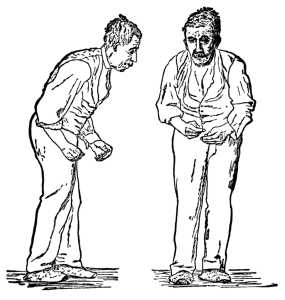[retweet][facebook]
Researchers confirm that acupuncture and other Traditional Chinese Medicine (TCM) procedures are effective Parkinson’s disease treatment modalities. Specialized TCM procedures demonstrating efficaciousness include scalp acupuncture, moxibustion, and acupotomy. The researchers conducted a meta-analysis and concluded that acupuncture significantly improves the overall condition of Parkinson’s disease patients.
Parkinson’s disease is a nervous system disorder characterized by tremors, slow movements (bradykinesia), rigidity of musculature, balance disorders, and difficulty with daily activities including writing and speaking. There is no known cure for Parkinson’s disease. Medications used to control Parkinson’s disease include levodopa, dopamine agonists, MAO-B inhibitors, COMT inhibitors, anticholinergics, and amantadine. Additionally, deep brain stimulation and surgery may be employed.
 Parkinson’s disease was recognised as a biomedical condition in the occident after the publication of James Parkinson’s An Essay on the Shaking Palsy in 1817. James Parkinson became a surgeon at the age of 29 in 1784 after graduating from London Hospital Medical College. A decorated humanitarian, Dr. Parkinson advocated for progressive social reforms.
Parkinson’s disease was recognised as a biomedical condition in the occident after the publication of James Parkinson’s An Essay on the Shaking Palsy in 1817. James Parkinson became a surgeon at the age of 29 in 1784 after graduating from London Hospital Medical College. A decorated humanitarian, Dr. Parkinson advocated for progressive social reforms.
Various forms of tremor disorders and their treatment regimens have been documented for over 1,000 years in Traditional Chinese Medicine. The research conducted by Qiu Congsheng et al. evaluates several approaches to symptomatic improvements. The researchers add that an advantage to acupuncture treatments is that, unlike many medications used in the treatment of Parkinson’s disease, it does not cause dyskinesia.
The meta-analysis examined the groundbreaking work of Zhou Sha. A sample size of 40 patients was treated with the following primary acupuncture points:
- Ya Men (DU15)
- Feng Chi (GB20)
- Wan Gu (SI4)
- Tian Shu (ST25)
The research demonstrates that the patients had significant improvements in physical, behavioral, and mental indices. Yuan Yin et al. used the same primary acupuncture points and achieved significant improvements for patients with Parkinson’s disease. The acupoint prescription is referred to as the ‘Lu Di 7 point’ combination. Three of the acupoints are bilateral and one acupoint is unilateral for a total of 7 acupuncture points. In another body of work examined in the meta-analysis, Huang Na et al. demonstrated that scalp acupuncture benefitted patients and significant reductions of insomnia were achieved.
TCM body style acupuncture has been shown to benefit Parkinson’s disease patients. Ren Xiaoming et al. targeted their treatment strategy towards befitting the liver and kidney and achieved significant positive patient outcomes for patients with Parkinson’s disease. The primary acupuncture points were:
- Gan Yu (BL18)
- Xian Yu (BL23)
- Feng Chi (GB20)
- Qu Chi (LI11)
- He Gu (LI4)
- Yang Ling Quan (GB34)
- Tai Xi (KD3)
- Tai Chong (LV3)
Yao Xiaoping randomly distributed 57 patients with Parkinson’s disease into a treatment group and control group, which consisted of 30 and 27 patients respectively. The treatment group patients received acupuncture plus levodopa. Patients from the control group received only levodopa. After a month, researchers compared results obtained from both groups and assessed criteria such as facial expression, posture, linguistic ability, pace, dyskinesia, shaking, rigidity, etc…. The treatment group achieved a total efficacy rate of 93.3% and the control group achieved a 66.7% total effective rate. The results indicate that combining acupuncture therapy with levodopa has additive or synergistic effects. In other findings, Zhu Fangjian et al. demonstrated that acupuncture alleviates constipation for patients with Parkinson’s disease.
Wang Shun et al. employed the use of threading style acupuncture with a high total effective rate for relieving the symptoms of Parkinson’s disease. Primary threaded acupoint pairs included:
- Qian Ding (DU21) – Xuan Lu (GB5)
- Nao Hu (DU17) – Feng Fu (DU16)
- Yu Zhen (BL9) – Tian Zhu (BL10)
- Nao Kong (GB19) – Feng Chi (GB20)
Xu Guoqing et al. focused on the TCM principles of alleviating liver and kidney disorders, controlling damp stagnation, and improving blood circulation. The researchers note that this acupuncture treatment protocol lessened the toxic adverse effects due to medication consumption and reduced tremors.
Acupotomy has also demonstrated benefits to Parkinson’s disease patients. This is an aggressive style of needling and is a form of microsurgery often used to remove adhesions. Researchers have combined acupotomy with scalp acupuncture and have achieved significant clinical results.
Deng Xianbin et al. used moxibustion and achieved significant clinical results for patients with Parkinson’s disease. Significant improvements were noted in the relief of myotonia and improvement of functional bodily movements. The following were primary acupoints receiving moxibustion:
- Zhong Wan (CV12)
- Qi Hai (CV6)
- Guan Yuan (CV4)
- Dan Shu (BL19)
- Ge Shu (BL17),
- Da Zhui (DU14)
- Ming Men (DU4)
Zhong Ping et al. evenly distributed 60 Parkinson’s patients into a treatment group and a control group. The treatment group received Madopar, a Parkinson’s disease medication, plus moxibustion at the following acupoints including:
- Zhong Wan (CV12)
- Xia Wan (CV10)
- Qi Hai (CV6)
- Guan Yuan (CV4)
- Ming Men (DU4)
The control group only received Madopar. After 7 months of treatment, the moxibustion plus Madopar group achieved a total effective rate of 93.3% whereas the Madopar only group achieved a 63.3% total effective rate. The results indicate that an integrative therapy model improves patient outcomes.
Excerpt from:
